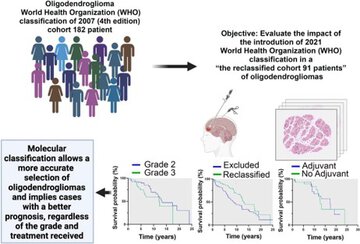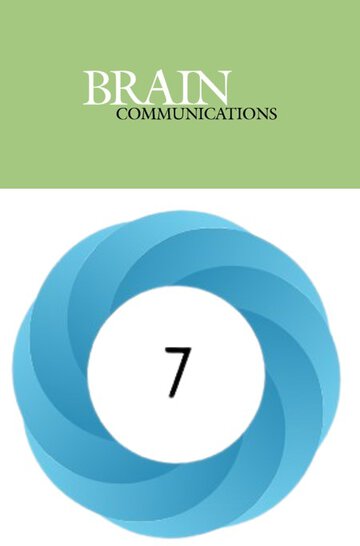Vaz MA, Sepulveda JM, Earl J, Gutierrez J, Ruano Y, Pian H, Cantero D, Hernández A. Oligodendrogliomas: findings after classifying the same cohort using pre- and post-World Health Organization (WHO) 2021 criteria
Brain Commun. 2025
"We Provide Real-World Evidence That WHO 2021 Classification Sharply Improves Patient Stratification in Oligodendroglioma". - Drs. Vaz-Salgado & Earl
Summary:
The 2021 World Health Organization (WHO) classification includes the presence of isocitrate dehydrogenase (IDH) mutation and 1p/19q codeletion for oligodendrogliomas. The objective of this study was to evaluate the impact of the introduction of this classification in a cohort of oligodendrogliomas. A total of 182 cases with an initial diagnosis of oligodendroglioma by histological criteria were identified, including Grades 2 and 3 and oligoastrocytoma (initial cohort). Subsequently, IDH mutation and 1p/19q codeletion were determined and were present in a total of 91 cases (reclassified cohort). The clinical evolution of both cohorts was analyzed. The mean age was 45 years (14-75), 65% were Grade 2 and 22% were oligoastrocytomas. Complete resection was performed in 47% and biopsy in 7%. After surgery, 50% received radiotherapy, 30% chemotherapy and 36% did not receive adjuvant therapy. In the reclassified cohort, there were no statistically significant differences between Grade 2 and Grade 3 oligodendrogliomas, the median overall survival (OS) in Grade 2 was 13.3 years [95% confidence interval (CI) 8.2-18.4] and 12 years in Grade 3 (95% CI 5.6-18.3). However, in the initial cohort, significant differences were found according to tumour grade. Even in cases without adjuvant treatment, the median OS was 12 years. Compared with this data, the median OS for the cohort that did not meet IDH mutation and 1p/19q codeletion criteria was 7.52 years (95% CI 4.67-10.38). Molecular classification allows a more accurate selection of oligodendrogliomas and implies cases with a better prognosis, regardless of the grade and treatment received. These data should be taken into account in clinical practice and clinical trials.
Why do you highlight this publication?
This is a novel study on oligodendrogliomas, a rare type of brain tumor, has provided significant evidence supporting the latest World Health Organization (WHO) classification system. The research, which boasts one of the largest case series for this uncommon tumor, demonstrates that molecular parameters are paramount for precise diagnosis and prognosis, effectively surpassing the traditional importance of tumor grade.
This study is the first of its kind to specifically analyze the real-world impact of the 2021 WHO classification change on a large cohort of patients. The revised guidelines mandate the use of molecular markers-specifically, IDH mutation and 1p/19q codeletion-to define a true oligodendroglioma.
The research analyzed 182 patients initially diagnosed with oligodendroglioma based on older histological criteria. After re-evaluating these cases with modern molecular testing, only 91 cases were confirmed as genetically-defined oligodendrogliomas. This reclassification proved to be critically important for predicting patient outcomes.
The key finding of the study is that in the molecularly-defined cohort, there were no statistically significant differences in overall survival between patients with Grade 2 and Grade 3 tumors. The median overall survival was 13.3 years for Grade 2 and 12 years for Grade 3, indicating that the histological grade has lost its prognostic significance when the tumor has the defining IDH and 1p/19q molecular signature.
Furthermore, the study confirmed that this molecular signature identifies a group of tumors with a consistently better prognosis. Even among patients who received no adjuvant therapy after surgery, the median overall survival was 12 years. In contrast, patients whose tumors did not meet the molecular criteria for oligodendroglioma had a significantly lower median overall survival of 7.52 years.
"These findings are transformative for clinical practice," stated the lead researcher. "Molecular classification allows for a more accurate selection of true oligodendrogliomas, which represent a distinct disease entity with a more favorable prognosis, independent of the tumor grade or the treatment received. This clarity is crucial for guiding patient management and for the design of future clinical trials."
The study concludes that the 2021 WHO classification is a vital step forward in neuro-oncology, enabling a more precise and prognostically relevant diagnosis for patients with oligodendrogliomas.
Publication commented by:
Drs. María Ángeles Vaz-Salgado & Julie Earl.
BIOMARKERS AND PERSONALIZED APPROACH TO CANCER GROUP (BIOPAC). IRYCIS



